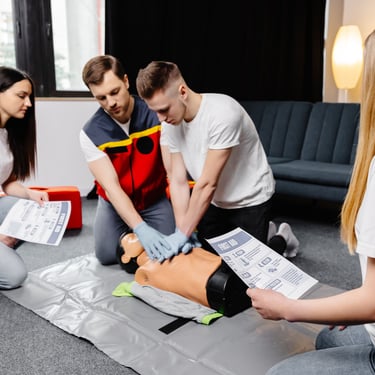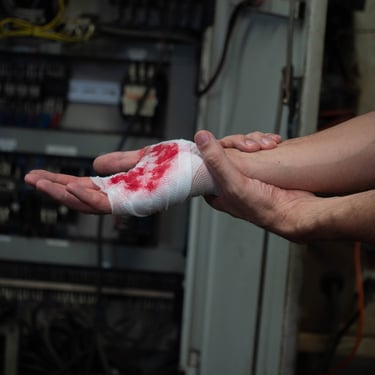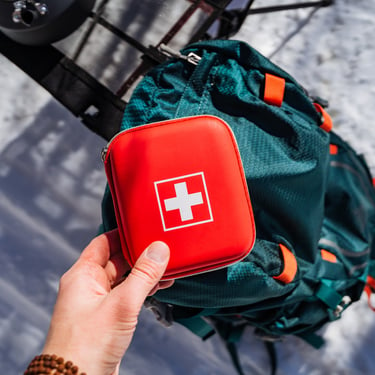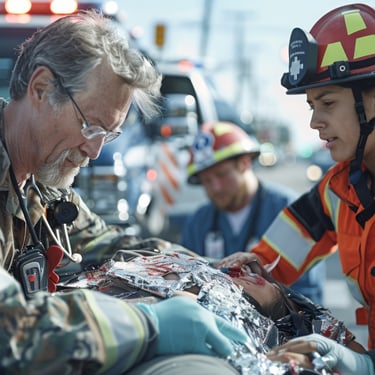MEDICAL SKILLS:
Emergencies can happen anytime, anywhere. Knowing essential medical skills could mean the difference between life and death. From treating minor wounds to responding to serious medical situations, being prepared is invaluable.




This guide will walk you through key medical skills you should know and recommend trusted products that can help you respond effectively.
1. Build a Complete First Aid Kit
Having a well-stocked first aid kit is crucial. It allows you to respond quickly to injuries, preventing them from becoming more severe. A comprehensive kit should include bandages, antiseptic wipes, gauze, medical tape, tweezers, scissors, and gloves.
Key Items to Include:
Adhesive bandages of different sizes
Antiseptic ointment and alcohol prep pads
Sterile gauze pads and medical tape
Instant cold packs
Tweezers and scissors
Latex-free gloves
Real-Life Example: After a hurricane, debris and broken glass are common hazards. A first aid kit allows you to quickly clean and bandage cuts, preventing infection in a situation where medical facilities might be overwhelmed.
Top Pick: Comprehensive First Aid Kit
Surviveware First Aid Kit – These kits contains medical-grade items and comes in a durable, organized case. Perfect disaster emergencies.
Add-on:
Johnson & Johnson All-Purpose First Aid Kit – Compact and budget-friendly, ideal for travel or office use.
2. Learn CPR and How to Use an AED
Cardiopulmonary resuscitation (CPR) and automated external defibrillators (AED) can save lives during cardiac arrest. CPR keeps blood and oxygen circulating, while an AED can restart the heart.
Steps for CPR:
Check for responsiveness and breathing.
Call 911 immediately.
Begin chest compressions – push hard and fast in the center of the chest at a rate of 100-120 compressions per minute.
If trained, give rescue breaths after every 30 compressions.
Practical Scenario: During a power outage caused by a natural disaster, an elderly neighbor collapses. By administering CPR until help arrives, you provide critical life-saving support in a situation where emergency services may be delayed.
Recommended Book for CPR:
“CPR, AED & First Aid Certification Guide” by American Safety Council – A comprehensive guide to understanding and performing CPR and using an AED.
Top Pick: Portable AED Trainer
WNL Products CPR & AED Training Kit – Practice using an AED with this portable and realistic training kit.
3.Master Wound Care and Bleeding Control
Knowing how to control bleeding is a critical skill in emergencies. Applying pressure, using gauze, and utilizing a tourniquet can stop severe blood loss and save lives.
Techniques for Bleeding Control:
Apply firm pressure to the wound using gauze or a clean cloth.
Elevate the injured area if possible.
Use a tourniquet for severe bleeding that cannot be controlled by pressure alone.
Scenario: After a tornado strikes, you find a neighbor with a deep leg wound from flying debris. Using gauze and a tourniquet from your trauma kit, you stabilize the injury until emergency responders arrive.
Recommended Books for Wound Care:
“Emergency War Surgery” by the U.S. Department of the Army – Learn how to handle severe wounds in crisis situations.
“First Aid Manual” by DK – A practical and easy-to-follow first aid guide.
Top Pick: Trauma Kit
EVERLIT Emergency Trauma Kit – Contains a tourniquet, hemostatic gauze, and other bleeding control essentials.
Add-on:
QuikClot Advanced Clotting Gauze – A must-have for rapid clotting and wound care.
4. Treat Burns and Scalds
Burn injuries are common but can lead to complications if not treated properly. Understanding how to cool burns, apply sterile dressings, and prevent infection is essential.
First Aid for Burns:
Run cool (not cold) water over the burn for 10-15 minutes.
Apply a sterile, non-stick dressing.
Avoid popping blisters.
Example: In the aftermath of a wildfire, hot surfaces and embers can cause burns. Immediate cooling and dressing of the injury can prevent worsening and reduce the risk of infection.
Top Pick: Burn Care Kit
Water Jel Burn Kit – This kit provides burn dressings and gel to immediately soothe and treat burns.
5. Manage Choking and Airway Blockages
Choking can occur suddenly and requires immediate action. Knowing the Heimlich maneuver and having tools to clear airway blockages is vital.
Scenario: During an earthquake, a family member begins choking on food in a high-stress environment. Knowing how to perform the Heimlich maneuver or using an anti-choking device can save their life when emergency services are delayed.
Top Pick: Anti-Choking Device
LifeVac Anti-Choking Device – A non-invasive device designed to quickly and safely remove airway obstructions.
6. Handle Broken Bones and Sprains
Stabilizing fractures and supporting sprains is essential to prevent further injury. Knowing how to use splints, slings, and cold compresses is key.
Scenario: After a flood, a friend slips and fractures their arm while evacuating. Using a splint and sling from your emergency kit can stabilize the injury until professional medical care is available.
Recommended Book:
Top Pick: Emergency Splint Kit
Ever Ready First Aid Splint Kit – Lightweight, versatile splints for immobilizing broken bones and injuries.
Final Thoughts
Learning basic medical skills empowers you to take control during emergencies, protect your loved ones, and potentially save lives. Equip yourself with knowledge and quality medical products today.
Disclaimer:
This site contains affiliate links to Amazon. As an Amazon Associate, I may earn a commission from qualifying purchases. Your support helps keep the site running, with no extra charge to you.
The information provided on this website is for general informational purposes only. While we strive to ensure accuracy and reliability, the content is not intended as professional advice. Always consult with qualified professionals for specific needs or situations.
